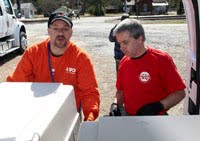Submitted by Angela Shields, EARS Field Team Leader (pictured at top)
This was my first deployment as a Field Team Leader for UAN, and actually going out to the field on seizure day was an experience that I'll never forget. The ASPCA team runs like a well-oiled machine and was amazing at orchestrating the removal of the survivors. The survivors thanked us EARS volunteers every day they were in our care. Dogs who had to be carried off the property because they were too scared or too weak to walk had a new lease on life after having clean sheets (cedar shavings), clean water and feedings three times a day.

Every deployment seems to have a few random species of animals, and this one was no exception. Snowman, the cat from the first seizure (pictured at right), became known as "The Dogfather" and lived in the lap of luxury at the temporary shelter. The volunteers made him a "condo" complete with with a kitty sling. He was very respectful as an intact male and only used his litterbox. I wish I could have brought him home, but I know he'll end up with a loving family. Chicklet the Chicken from the second seizure was The Dogfather's roommate, and there were rumors of the two playing chess after we left at night. Chicklet was placed with a lady who has about 10 other pet pullets.
It was difficult to leave this deployment and return home, as the job wasn't quite done, but my commitment was fulfilled and my body and mind were exhausted. What an awesome experience!
Photos this post courtesy ASPCA.












